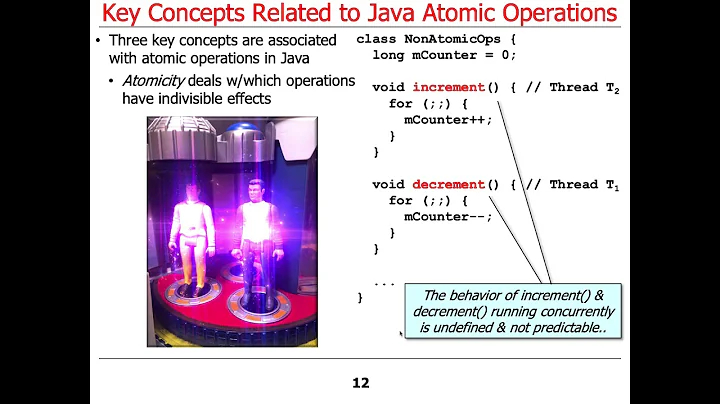How to explain atomic actions?
Solution 1
Maybe you should think about transactions. Make some process but do not save changes until everything is in order. Like when you are withdrawing money from a machine, you follow a series of steps, before seeing changes on your account, i.e. Put your card, your password, say how much money you want, receive the money. If something fails in one of the steps, you dont see changes in your savings account, e.g. your password was incorrect, or you are trying to withdraw more money than what you have...
You can read the java tutorial. http://docs.oracle.com/javase/tutorial/essential/concurrency/atomic.html
Solution 2
Your explanation, IMHO, rather explains what atomicity means regarding database transactions: the A in ACID.
Regarding concurrency, atomicity rather means that when a thread modifies the state of some object (or set of objects), another thread can't see any intermediary state. Either it sees the state as it was before the operation, or it sees the state as it is after the operation.
For example, changing the value of a long variable is not an atomic operation. It involves setting the value of the 32 first bits, and then setting the state of the 32 last bits. If the access to the long variable is not properly synchronized, a thread might see the intermediary state: the 32 first bits have been changed, but the 32 last bits haven't been changed yet.
The way to implement atomic operations is to use synchronization. synchronization involves using
- the synchronized keyword
- the volatile keyword
- atomic variables (AtomicInteger, etc.)
Solution 3
well, is not that an atomic action cannot be stopped in the middle. Is more: all his effects become visible when the action is completed (commit) or are not visible at all (abort/rollback); so it can be stopped, but the state of the system is not updated.
Solution 4
By reading the Java tutorial on Atomic Access
Related videos on Youtube
user1014888
Updated on June 04, 2022Comments
-
user1014888 almost 2 years
What are atomic actions and why they are neccessary? Also, How are atomic actions implemented in Java?
My understanding is that in programming an atomic action is one that effectively happens all at one. An atomic action cannot stop in the middle it either happens completely or not at all.
For example, ordering an airline ticket online where two actions are required: payment and a seat reservation. The potential passenger must either.
- both pay and reserve a seat, OR
- neither pay nor reserve a seat
-
Brian Roach over 12 yearsSounds like ... homework.
-
user1014888 over 12 yearsGreat thanks, that answers my question perfect and your example is easy to understand.
-
Neil Masson over 8 yearsPlease pay attention to your spelling. Your answer is very hard to read.
-
Sai Teja over 8 yearsSorry for that,im using shortcuts here......transctn for transaction..extcd for executed
-
N.S. about 2 yearsYour first sentence distinguishing atomicity in database transactions from atomicity in programming is spot on. Nearly all the other answers below (and some comments to the OP question) miss this point, with irrelevant references to database transactions.
-
N.S. about 2 yearsYour answer confuses database transaction atomicity with programming atomicity. See the first answer







